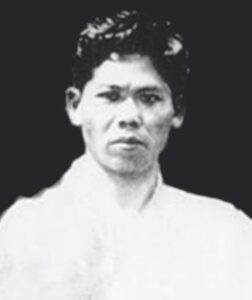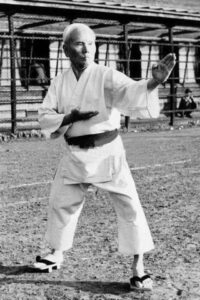
Yoshitaka “Gigo” Funakoshi was born in Okinawa in 1906. Already from childhood, he was diagnosed with tuberculosis, which was also the cause of his death in 1945. Yoshitaka began his formal training in Karate when he was 12 years old, as a means to improve his health.
At the age of 17, Yoshitaka traveled with his father Gichin Funakoshi to Tokyo. The task was to spread Karate in mainland Japan.
The change in Style

Over the years, the Okinawan interpretation of Karate changed from a self-defense fighting technique to a philosophical and mental way of Karate practicing. I will attribute that change to Gichin Funakoshi and maybe Kenwa Mabuni (Mabuni arrived in Japan in 1928), in connection with the introduction of Karate in mainland Japan. But the change did not stop there. Yoshitaka Funakoshi changed and developed a Karate style that definitively separated Japanese Karate-Do from the local Okinawan arts, it received a notoriously Japanese flavor. Those changes were probably made around 1930 and in the years thereafter.
The old techniques from To-de, Tomari-te, and Shuri-te emphasized the use and development of the upper body, open hand attacks, short distances, joint locks, basic grappling, pressure point striking, and use of the front kick and variations of it.
Yoshitaka introduced
